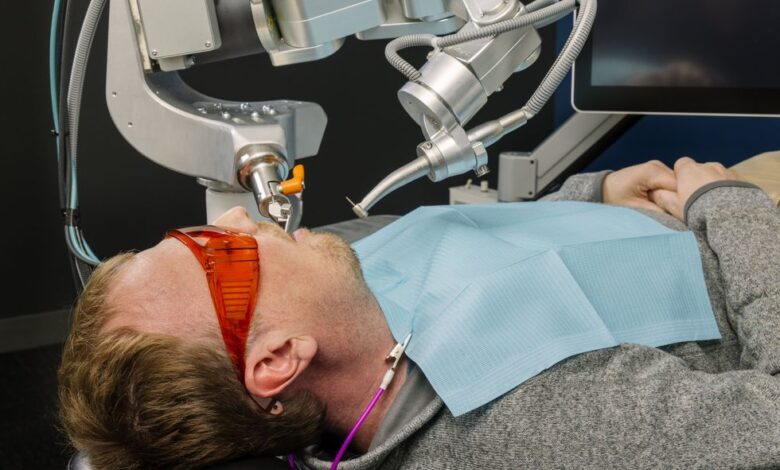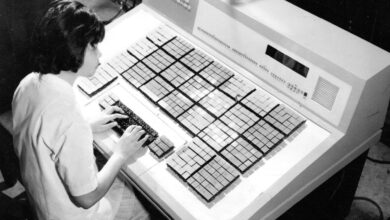A Robot Dentist Might Be a Good Idea, Actually

I’ll be honest: when I first got this pitch for an autonomous robot dentist, I was like: “Okay, I’m going to talk to these folks and then write an article, because there’s no possible way for this thing to be anything but horrific.” Then they sent me some video that was, in fact, horrific, in the way that only watching a high speed drill remove most of a tooth can be.
But fundamentally this has very little to do with robotics, because getting your teeth drilled just sucks no matter what. So the real question we should be asking is this: How can we make a dental procedure as quick and safe as possible, to minimize that inherent horrific-ness?And the answer, surprisingly, may be this robot from a startup called Perceptive.
Perceptive is today announcing two new technologies that I very much hope will make future dental experiences better for everyone. While it’s easy to focus on the robot here (because, well, it’s a robot), the reason the robot can do what it does (which we’ll get to in a minute) is because of a new imaging system. The handheld imager, which is designed to operate inside of your mouth, uses optical coherence tomography (OCT) to generate a 3D image of the inside of your teeth, and even all the way down below the gum line and into the bone. This is vastly better than the 2D or 3D x-rays that dentists typically use, both in resolution and positional accuracy.
Perceptive’s handheld optical coherence tomography imager scans for tooth decay.Perceptive
X-Rays, it turns out, are actually really bad at detecting cavities; Perceptive CEO Chris Ciriello tells us that the accuracy is on the order of 30 percent of figuring out the location and extent of tooth decay. In practice, this isn’t as much of a problem as it seems like it should be, because the dentist will just start drilling into your tooth and keep going until they find everything. But obviously this won’t work for a robot, where you need all of the data beforehand. That’s where the OCT comes in. You can think of OCT as similar to an ultrasound, in that it uses reflected energy to build up an image, but OCT uses light instead of sound for much higher resolution.
Perceptive’s imager can create detailed 3D maps of the insides of teeth.Perceptive
The reason OCT has not been used for teeth before is because with conventional OCT, the exposure time required to get a detailed image is several seconds, and if you move during the exposure, the image will blur. Perceptive is instead using a structure from motion approach (which will be familiar to many robotics folks), where they’re relying on a much shorter exposure time resulting in far fewer data points, but then moving the scanner and collecting more data to gradually build up a complete 3D image. According to Ciriello, this approach can localize pathology within about 20 micrometers with over 90 percent accuracy, and it’s easy for a dentist to do since they just have to move the tool around your tooth in different orientations until the scan completes.
Again, this is not just about collecting data so that a robot can get to work on your tooth. It’s about better imaging technology that helps your dentist identify and treat issues you might be having. “We think this is a fundamental step change,” Ciriello says. “We’re giving dentists the tools to find problems better.”
The robot is mechanically coupled to your mouth for movement compensation.Perceptive
Ciriello was a practicing dentist in a small mountain town in British Columbia, Canada. People in such communities can have a difficult time getting access to care. “There aren’t too many dentists who want to work in rural communities,” he says. “Sometimes it can take months to get treatment, and if you’re in pain, that’s really not good. I realized that what I had to do was build a piece of technology that could increase the productivity of dentists.”
Perceptive’s robot is designed to take a dental procedure that typically requires several hours and multiple visits, and complete it in minutes in a single visit. The entry point for the robot is crown installation, where the top part of a tooth is replaced with an artificial cap (the crown). This is an incredibly common procedure, and it usually happens in two phases. First, the dentist will remove the top of the tooth with a drill. Next, they take a mold of the tooth so that a crown can be custom fit to it. Then they put a temporary crown on and send you home while they mail the mold off to get your crown made. A couple weeks later, the permanent crown arrives, you go back to the dentist, and they remove the temporary one and cement the permanent one on.
With Perceptive’s system, it instead goes like this: on a previous visit where the dentist has identified that you need a crown in the first place, you’d have gotten a scan of your tooth with the OCT imager. Based on that data, the robot will have planned a drilling path, and then the crown could be made before you even arrive for the drilling to start, which is only possible because the precise geometry is known in advance. You arrive for the procedure, the robot does the actually drilling in maybe five minutes or so, and the perfectly fitting permanent crown is cemented into place and you’re done.
The robot is still in the prototype phase but could be available within a few years.Perceptive
Obviously, safety is a huge concern here, because you’ve got a robot arm with a high-speed drill literally working inside of your skull. Perceptive is well aware of this.
The most important thing to understand about the Perceptive robot is that it’s physically attached to you as it works. You put something called a bite block in your mouth and bite down on it, which both keeps your mouth open and keeps your jaw from getting tired. The robot’s end effector is physically attached to that block through a series of actuated linkages, such that any motions of your head are instantaneously replicated by the end of the drill, even if the drill is moving. Essentially, your skull is serving as the robot’s base, and your tooth and the drill are in the same reference frame. Purely mechanical coupling means there’s no vision system or encoders or software required: it’s a direct physical connection so that motion compensation is instantaneous. As a patient, you’re free to relax and move your head somewhat during the procedure, because it makes no difference to the robot.
Human dentists do have some strategies for not stabbing you with a drill if you move during a procedure, like putting their fingers on your teeth and then supporting the drill on them. But this robot should be safer and more accurate than that method, because of the rigid connection leading to only a few tens of micrometers of error, even on a moving patient. It’ll move a little bit slower than a dentist would, but because it’s only drilling exactly where it needs to, it can complete the procedure faster overall, says Ciriello.
There’s also a physical counterbalance system within the arm, a nice touch that makes the arm effectively weightless. (It’s somewhat similar to the PR2 arm, for you OG robotics folks.) And the final safety measure is the dentist-in-the-loop via a foot pedal that must remain pressed or the robot will stop moving and turn off the drill.
Ciriello claims that not only is the robot able to work faster, it also will produce better results. Most restorations like fillings or crowns last about five years, because the dentist either removed too much material from the tooth and weakened it, or removed too little material and didn’t completely solve the underlying problem. Perceptive’s robot is able to be far more exact. Ciriello says that the robot can cut geometry that’s “not humanly possible,” fitting restorations on to teeth with the precision of custom-machined parts, which is pretty much exactly what they are.
Perceptive has successfully used its robot on real human patients, as shown in this sped-up footage. In reality the robot moves slightly slower than a human dentist.Perceptive
While it’s easy to focus on the technical advantages of Perceptive’s system, dentist Ed Zuckerberg (who’s an investor in Perceptive) points out that it’s not just about speed or accuracy, it’s also about making patients feel better. “Patients think about the precision of the robot, versus the human nature of their dentist,” Zuckerberg says. It gives them confidence to see that their dentist is using technology in their work, especially in ways that can address common phobias. “If it can enhance the patient experience or make the experience more comfortable for phobic patients, that automatically checks the box for me.”
There is currently one other dental robot on the market. Called Yomi, it offers assistive autonomy for one very specific procedure for dental implants. Yomi is not autonomous, but instead provides guidance for a dentist to make sure that they drill to the correct depth and angle.
While Perceptive has successfully tested their first-generation system on humans, it’s not yet ready for commercialization. The next step will likely be what’s called a pivotal clinical trial with the FDA, and if that goes well, Cirello estimates that it could be available to the public in “several years”. Perceptive has raised US $30 million in funding so far, and here’s hoping that’s enough to get them across the finish line.
IEEE Spectrum




